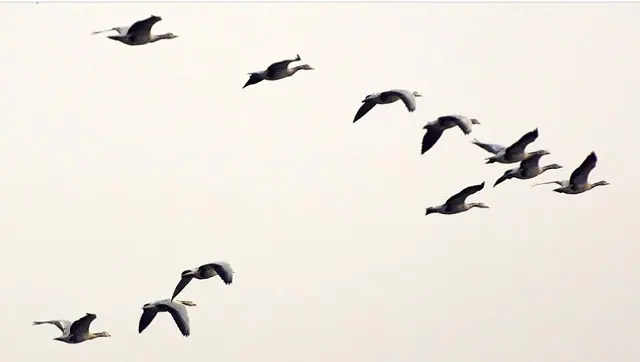Regular monitoring of wild aquatic birds and the wild bird-poultry-wetland interface is essential to understanding avian influenza viruses’ prevalence.
By Sahana Ghosh
As avian flu swept through India towards the end of 2020 and early 2021, states scrambled to step up vigil and measures to control the spread of the disease. The 2020/2021 outbreak, marked by the significant involvement and mortality of wild birds, has spotlighted the need for proactive monitoring of animal disease in the environment, conserving unprotected wetland habitats to curb disease spread, and addressing knowledge gaps like the wild waterfowl–poultry interface.
Avian Influenza (AI) is a highly contagious viral disease that affects both domestic and wild birds. AI occurs worldwide, and different strains are more prevalent in certain areas of the world than others. According to the World Organisation for Animal Health, wild aquatic birds, such as geese, shorebirds, and wild ducks, are the natural reservoirs of influenza A viruses. AI viruses are broadly classified as low pathogenic AI (LPAI) and highly pathogenic AI (HPAI) viruses, based on their pathogenicity.
The latest bird flu outbreak in poultry and wild birds spanned 14 Indian states/Union Territories from Jammu and Kashmir in the north to Kerala in the south. Haryana, Maharashtra, Punjab, and Kerala were particularly severely affected. The latest outbreak involved highly pathogenic viral strains H5N1 and H5N8, according to the Indian government.
“Avian influenza and other zoonotic diseases are in the environment, and as human activities encroach natural habitats and environments used by wild species, the risk of transmission increases. We have reached a stage where we must proactively enhance monitoring of wild bird and animal disease in our environment to act as an early warning system of change/arrival of potential diseases,” Taej Mundkur, International Waterbird Census Coordinator and Senior Technical Officer, Wetlands International (The Netherlands), told Mongabay-India.
“Such a surveillance programme should be developed through organising year-round passive and active surveillance at a network of locations across the country. This will allow us to be better prepared and respond when a new pathogen or new strain of a known pathogen arrives,” said Mundkur, adding that the One Health framework, in its broadest sense, aims to improve the health of humans, agriculture, and wildlife/environment and recognises this web of interconnections and interactions across our planet earth.
The Ramsar Convention on Wetlands and the Convention on Migratory Species and the Scientific Task Force on Avian Influenza and Migratory Birds have provided valuable international guidance on responses/actions to avian influenza in the wild birds-wetland interface, adds Mundkur. They include ensuring that there is no consideration of killing wild birds, spraying toxic products, or negatively affecting wetland habitats as disease control measures, guidance on disease control measures are relevant for both Ramsar sites and all other protected and unprotected wetlands and increasing biosecurity of wetland site.
India has emerged as a global hotspot for HPAI H5N1, while also providing critical wintering habitat for many species of migratory waterfowl and year-round habitat for several resident waterfowl species. The country lies at the heart of the Central Asian Flyway (CAF), which spans 30 countries and covers 279 populations of 182 migratory waterbird species that rely on wetlands along the flyway, including the Pong Dam wetlands (Pong Lake Wildlife Sanctuary), a Ramsar site, where large scale mortalities of long-distance migratory birds such as bar-headed geese, first alerted biologists in December 2020.
Reports of deaths of over 2000 birds at Pong Lake in Himachal Pradesh were followed by alerts of peacock mortalities in Maharashtra, deaths of lapwings near Kharo Dam in Gujarat’s Junagadh district, and jungle crows in Uttarakhand. Upon confirmation of the avian flu outbreak, a total of 4,49,271 poultry birds were culled till February 12, 2021, to control the disease spread, as per the National Action Plan for Prevention, Control, and Containment of Avian Influenza. India’s poultry sector is valued at about Rs. 80,000 crore and employs over 10 lakh farmers.

A flock of waterbirds in an urban wetland. Monitoring poultry-wildbird-wetlands interface is crucial to study avian influenza. Photo by Christy Bharath.
Addressing knowledge gaps
Knowledge gaps remain in the nature of the wild waterfowl–poultry interface and the sharing of diverse wetland habitat among these birds.
Evolutionary ecologist Farah Ishtiaq underscored the need for a well-designed study to screen poultry and domestic waterfowl for low pathogenic viruses. “We lack such data,” Ishtiaq told Mongabay-India. “High species diversity and low water temperature are known to enhance virus survival in certain parts of the world. However, in the Indian context, poultry plays a huge role in circulating the virus throughout the year. Therefore, there have been reports of outbreaks in nonseason time as well,” added Ishtiaq, senior scientist at Tata Institute for Genetics and Society. She stressed on rapid testing for confirming the cause of death of wild birds. “Viruses are very sensitive to temperature and RNA degrades really fast with an increase in temperature. We need a simplified system to screen such samples in real-time as the cases are reported to ascertain the cause and viral strain,” said Ishtiaq.
According to landscape epidemiologist Michael Walsh, co-author of a 2020 study that systematically investigated the extent of the interface between wild waterfowl and poultry and its influence on the risk of HPAI H5N1 outbreaks in India, there was evidence of interaction between poultry and wild waterfowl concerning H5N1 outbreaks.

The sharing of water resources in wetland habitat is fundamental to understanding the wild waterfowl–poultry interface and the avian influenza virus, subtype H5N1. This virus infects, and is shed by, the intestinal tract of both waterfowl and poultry and thus the water bodies used by these birds can serve as a common vehicle for waterborne transmission in processes of both spillover and spillback. Chart from Walsh, Michael G. et.al, Highly Pathogenic Avian Influenza (H5N1) Landscape Suitability Varies by Wetland Habitats and the Degree of Interface between Wild Waterfowl and Poultry in India (mdpi, 2020).
“Our results showed that outbreak risk did increase with increasing poultry density, which is in line with previous studies. However, what we also showed (and what previous studies have not explored) is that when you consider the landscapes where these poultry are held, outbreak risk was actually highest among low-density poultry holdings where poultry were in prime wild waterfowl habitat. Conversely, outbreak risk was higher among high-density poultry holdings only when those holdings were in areas where the poultry were least likely to come into contact with wild waterfowl,” Walsh, at the University of Sydney, told Mongabay-India.
The study also found that H5N1 outbreak occurrence was higher with greater proximity specifically to lakes, rivers, and coastal wetlands. These findings provide specific points in the landscape that may be good targets for interrupting the cycling of avian influenza viruses, for example, by blocking the mixed-use of surface water by domestic poultry and wild waterfowl.
While the emphasis should be on monitoring multiple waterbird sites of local, national, and international importance, surveillance is complicated by the nature of the poultry-wildbird-wetlands interface. “The story is not simple; domestic birds in an infected area are interacting with wild birds and some of these birds may be resident or migratory; the environment can be infected so you have these interactions happening in an area where there is an infection,” explained Mundkur.
“As poultry themselves don’t fly around, the virus can be carried in the trade of poultry/poultry products, pet birds, and in equipment (fomites) between farms and from the farms to wetlands and to markets. Once the virus is introduced into a wetland, it can infect migratory or domestic birds, and from where the virus can move to another area through local movements of these birds. This may then reinfect poultry or resident birds. Additionally, the virus may be picked up by predatory birds or raptors if they feed on dead or dying infected wild birds or poultry.”
There are many different peculiarities in dealing with the virus, and understanding the situation in an area is particularly important, he observed.
Farah Ishtiaq adds that unprotected wetlands are under constant pressure from urbanisation and pollution. With the loss of habitat and increase in poultry, the wildbird and poultry buffer has reduced and increased interaction and exchange of viruses – not just spillover but probably spillback from poultry as well, she said.
Kamal Saini, an assistant zoologist at Zoological Survey of India’s High Altitude Regional Centre at Solan, Himachal Pradesh, was part of the team that did an initial survey of Pong Dam wetlands in January following reports of mass death of migratory birds. He observed dead bar-headed geese, pochards, pin-tail, black stilt, sand plovers, mallard, spot-billed duck, coot, common teal, lapwing, among others at Pong.
“We saw the bar-headed geese trying to approach the land from the water, fall, squirm for a few minutes, and then drop dead. This was before avian influenza was confirmed. The forest department had put in place restrictions. After the birds die, their carcasses are attacked by predators like stray dogs, black kites, and tawny eagles; they may carry the virus to distant wild and domesticated animals,” Saini told Mongabay-India. So it remains a challenge for the department to bury the carcass before these predators attack them. “Additionally, the bar-headed geese that are unable to reach the bank, and die on the water may pose another threat to humans through consumption of affected fish,” he said.
Saini observed that every year thousands of winter migratory birds, such as the bar-headed goose, make a pit stop at Pong Dam and other wetlands on their journey from Central Asia, Tibet, Russia, Siberia, Mongolia and any changes in habitat quality can push them to look for alternative habitats.
Bar-headed goose (Anser indicus) is a long-distance migrant to the Indian subcontinent, with its major population breeding in China. There is a small breeding population in Ladakh, Mongolia, and Kyrgyzstan. Migrating bar-headed geese have been reported from many protected and non-protected wetlands of Assam, Himachal Pradesh, Jammu and Kashmir, Uttar Pradesh, Rajasthan, Andhra Pradesh, Odisha, Karnataka, Tamil Nadu, Kerala, and Maharashtra.
“This year their stoppages at Sukhna lake in Chandigarh were reduced, but they were seen in good numbers in small ponds in Haryana which means that protecting habitat quality even in these small water bodies is critical,” said Saini.
Researchers at Bangor University collaborating with a large international team of researchers, reported in 2011 that bar-headed geese can fly up to 6,000 m in only 8 hours while passing over the Himalayan mountain range – a similar intense climb could kill a human without lengthy acclimatisation. “When the birds arrive here they are subjected to fatigue following their long flight and they are more susceptible to the infection,” suspects Bivash Pandav, director, Bombay Natural History Society (BNHS), adding that the poultry and piggeries are the most susceptible to the virus.
“Most of these wetlands where you see migratory birds are unprotected sites, so involving communities in wetland management is essential,” Pandav told Mongabay-India.
Pandav reiterates regular health monitoring and sampling of wild birds in selected wetland spots to get a sense of the disease prevalence and the strains. “Otherwise, we try to do all this when the mortalities occur. At BNHS, we have been capturing and ringing birds in different parts of the country. But we are trying to incorporate the disease monitoring component into our ringing programme. We are looking for financial support for the analysis of the samples,” added Pandav.
***
This article was originally published on Mongabay.com.
Mongabay-India is an environmental science and conservation news service. This article has been republished under the Creative Commons license.
Subscribe to Moneycontrol Pro at ₹499 for the first year. Use code PRO499. Limited period offer. *T&C apply











